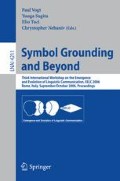Abstract
We suggest that the primary motivation for an agent to construct a symbol-meaning mapping is to solve a task. The meaning space of an agent should be derived from the tasks that it faces during the course of its lifetime. We outline a process in which agents learn to solve multiple tasks and extract a store of “cumulative knowledge” that helps them to solve each new task more quickly and accurately. This cumulative knowledge then forms the ontology or meaning space of the agent. We suggest that by grounding symbols to this extracted cumulative knowledge agents can gain a further performance benefit because they can guide each others’ learning process. In this version of the symbol grounding problem meanings cannot be directly communicated because they are internal to the agents, and they will be different for each agent. Also, the meanings may not correspond directly to objects in the environment. The communication process can also allow a symbol meaning mapping that is dynamic. We posit that these properties make this version of the symbol grounding problem realistic and natural. Finally, we discuss how symbols could be grounded to cumulative knowledge via a situation where a teacher selects tasks for a student to perform.
Access this chapter
Tax calculation will be finalised at checkout
Purchases are for personal use only
Preview
Unable to display preview. Download preview PDF.
References
Sowa, J.F.: Signs, processes, and language games (1999), Available Online: http://www.jfsowa.com/pubs/signproc.htm
Turing, A.M.: Computing machinery and intelligence. Mind 49, 433–460 (1950)
Newell, A., Simon, H.: Computer science as empirical inquiry: Symbols and search. Communications of the ACM 19, 113–126 (1976)
Searle, J.: Minds, brains, and programs. Behavioral and Brain Sciences 3, 417–457 (1980)
Harnad, S.: The symbol grounding problem. Physica D 42, 335–346 (1990)
Steels, L.: The evolution of communication systems by adaptive agents. In: Alonso, E., Kudenko, D., Kazakov, D. (eds.) AAMAS 2000 and AAMAS 2002. LNCS (LNAI), vol. 2636, pp. 125–140. Springer, Heidelberg (2003)
Vogt, P.: Language evolution and robotics: Issues in symbol grounding and language acquisition. In: Artificial Cognition Systems, Idea Group (2006)
Cangelosi, A., Harnad, S.: The adaptive value of symbolic theft over sensorimotor toil: Grounding language in perceptual categories. Evolution of Communication 4(1), 117–142 (2000)
Vogt, P.: Anchoring symbols to sensorimotor control. In: Proceedings of the 14th Belgian/Netherlands Artificial Intelligence Conference, BNAIC (2002)
Dunbar, K., Blanchette, I.: The inVivo/inVitro approach to cognition: The case of analogy. Trends in Cognitive Sciences 5, 334–339 (2001)
Hofstadter, D.R.: Analogy as the Core of Cognition. In: The Analogical Mind: Perspectives from Cognitive Science, pp. 499–538. The MIT Press, Cambridge (2001)
Omlin, C.W., Giles, C.L.: Extraction of rules from discrete-time recurrent neural networks. Neural Networks 9(1), 41–52 (1996)
Shavlik, J.: Combining symbolic and neural learning. Machine Learning 14(3), 321–331 (1994)
Bodén, M., Wiles, J.: Context-free and context-sensitive dynamics in recurrent neural networks. Connection Science 12(3,4), 197–210 (2001)
Thrun, S., Mitchell, T.: Lifelong robot learning. Robotics and Autonomous Systems 15, 25–46 (1995)
Caruana, R.: Multitask learning. Machine Learning 28, 41–75 (1997)
Swarup, S., Ray, S.R.: Cross domain knowledge transfer using structured representations. In: Proceedings of the Twenty-First National Conference on Artificial Intelligence (AAAI), Boston, MA, USA (2006)
Yan, X., Han, J.: CloseGraph: Mining closed frequent graph patterns. In: Proceedings of the 9th ACM SIGKDD conference on Knowledge-Discovery and Data Mining (KDD 2003) (2003)
Nicolescu, M.N., Matarić, M.J.: Task Learning Through Imitation and Human-Robot Interaction. In: Models and Mechanisms of Imitation and Social Learning in Robots, Humans and Animals: Behavioural, Social and Communicative Dimensions (2005)
Smith, A.D.M.: Mutual Exclusivity: Communicative Success Despite Conceptual Divergence. In: Language Origins: Perspectives on Evolution, pp. 372–388. Oxford University Press, Oxford (2005)
Smith, A.D.M.: Stable communication through dynamic language. In: Proceedings of the 2nd International Symposium on the Emergence and Evolution of Linguistic Communication, pp. 135–142 (2005)
Beule, J.D., Vylder, B.D., Belpaeme, T.: A cross-situational learning algorithm for damping homonymy in the guessing game. In: Rocha, L.M., Bedau, M., Floreano, D., Goldstone, R., Vespignani, A., Yaeger, L. (eds.) Proceedings of the Xth Conference on Artificial Life. The MIT Press, Cambridge (2006)
Steels, L., Vogt, P.: Grounding adaptive language games in robotic agents. In: Husbands, C., Harvey, I. (eds.) Proceedings of the Fourth European Conference on Artificial Life. MIT Press, Cambridge and London (1997)
Smith, K., Kirby, S., Brighton, H.: Iterated learning: A framework for the emergence of language. Artificial Life 9(4), 371–386 (2003)
Elman, J.L.: Learning and development in neural networks: The importance of starting small. Cognition 48, 71–99 (1993)
Clark, A., Thornton, C.: Trading spaces: Computation, representation and the limits of uninformed learning. Behavioral and Brain Sciences 20(1), 57–67 (1997)
de Solla Price, D.: A general theory of bibliometric and other cumulative advantage processes. Journal of the American Society for Information Science 27, 292–306 (1976)
Heidegger, M.: On the Way to Language. Harper, San Francisco (1982)
Author information
Authors and Affiliations
Editor information
Editors and Affiliations
Rights and permissions
Copyright information
© 2006 Springer-Verlag Berlin Heidelberg
About this paper
Cite this paper
Swarup, S., Lakkaraju, K., Ray, S.R., Gasser, L. (2006). Symbol Grounding Through Cumulative Learning. In: Vogt, P., Sugita, Y., Tuci, E., Nehaniv, C. (eds) Symbol Grounding and Beyond. EELC 2006. Lecture Notes in Computer Science(), vol 4211. Springer, Berlin, Heidelberg. https://doi.org/10.1007/11880172_14
Download citation
DOI: https://doi.org/10.1007/11880172_14
Publisher Name: Springer, Berlin, Heidelberg
Print ISBN: 978-3-540-45769-5
Online ISBN: 978-3-540-45771-8
eBook Packages: Computer ScienceComputer Science (R0)

